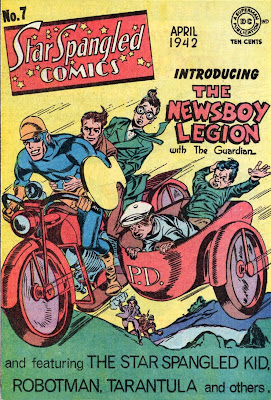A cascading cornucopia of cool comics, crazy cartoons, & classic collectables - plus other completely captivating & occasionally controversial contents. With nostalgic notions, sentimental sighings, wistful wonderings, remorseful ruminations, melancholy musings, rueful reflections, poignant ponderings, & yearnings for yesteryear. (And a few profound perplexities, puzzling paradoxes, & a bevy of big, beautiful, bedazzling, buxom Babes to round it all off.)
Monday, 24 September 2012
THE AMERICANS ARE COMING! (TOO LATE, THEY'RE HERE!)
8 comments:
ALL ANONYMOUS COMMENTS WILL BE DELETED UNREAD unless accompanied by a regularly-used and recognized
name. For those without a Google account, use the 'Name/URL' option. All comments are subject to moderation and will
appear only if approved. Remember - no guts, no glory.
I reserve the right to edit comments to remove swearing or blasphemy, and in instances where I consider certain words or
phraseology may cause offence or upset to other commenters.




.jpg)
Good to see you back Kid!
ReplyDeleteI really cannot imagine a life growing up without that unique and endlessley fascinating genre of literature, which is of course the "comic".Simple as its name suggests yet totally sublime in its scope and ability to inspire,exhilarate and transcend the mundane,taking kids such as myself then, with poor education and limited aspirations on a journey way beyond that which other forms of media could only begin to grasp at.
Yes,long live the Comic!
And long live Moonmando. (And me.)
ReplyDeletePretty interesting to read it right now. At least they found their way to the UK at all.
ReplyDeleteAnd thank goodness they did, Chris. They brightened up many a childhood.
ReplyDeleteI only simply recall in the 80's noticing both Marvel and DC putting UK prices on their books and not being sure why they did that (I guess it made sense when they were pricing them to Canada as usual).
ReplyDeleteIn the '60s, DC and Marvel comics also sometimes had U.K. prices on them - 10d and 1/-. What they did was remove the plates after the U.S. print run, change the price to British currency, and then print a fresh batch for U.K. distribution. In the case of Marvel, they removed the date from the small cover box which also contained the issue number, and added 'Distributed by Thorpe & Porter' to the indicia. However, issues also made their way over here simply rubber-stamped with the U.K. price on the cover.
ReplyDeleteAs for the '80s, with the advent of comic speciality shops and an established U.K. readership, it made sense to include the price on the cover. Previously, U.S. comics were mainly used as ballast on ships - in the late '70s and early/mid-'80s, they were now a genuine American export in their own right.
I remember reading about American comics being on sale in Woolies in Liverpool during WW2 with some even having slight water damage. Amazing to think that these comics had survived the U-boats and all the other hazards to land in some kid'a lap. I expect the GIs here may well have passed on a few here indirectly if stationed here pre D-Day. Imagine getting a Superman comic and a Hershey Bar as a child during those dark days!
ReplyDeleteKen.
I don't think I've ever tasted a Hershey Bar, Ken. Heard of them 'though.
ReplyDelete